Rules of Fat: Dialing in Tire Pressure
Posted by Kurt on 03/01/16
Last modified: 02/01/21
Written by Danielle Musto
Riding fat bikes on snow can be tricky. One day the snow might might be hard packed and fast, and the next day it might be soft and loose. Regardless of whether you are riding bikes for fun, or racing for a top spot on the podium, psi and tire choice can make or break your winter riding experience.
When I first started riding fat bikes I would always error on the side of caution and often rode with WAY TOO MUCH tire pressure. Very quickly I learned an important lesson. Too much tire pressure = less tire contact on snow = me crashing head first into a giant snow bank. Through trial and error I eventually established a few Rules of Fat to follow. These are just guidelines but they have helped me immensely.
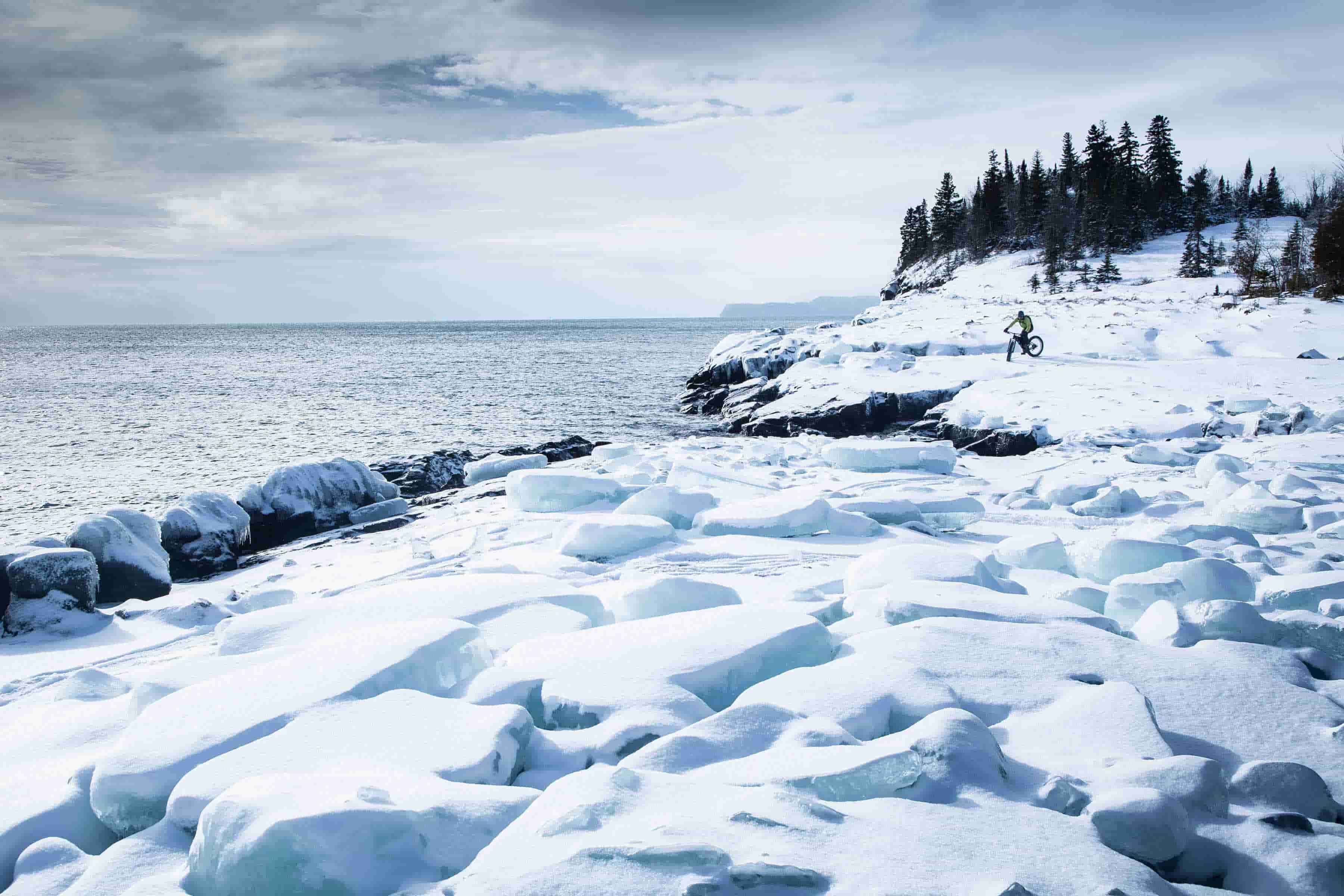
Rule #1: Pick a tire pressure starting point and adjust accordingly.
We all have different handling techniques and we all weigh different amounts. What is important is to determine a tire pressure that you know will work well on hard packed snow. Start out with that tire pressure and then adjust accordingly to snow conditions. I usually start out with 6 psi in my rear tire and 5.5-6 psi in the front. If I know the snow is going to be loose, I’ll drop down to 5 psi in the rear and 4-4.5 psi in the front. It may sound ridiculous, but letting out 1-2 psi in a fat bike tire will make a huge difference. It allows more tire contact on the surface of the snow, enabling you to float over it instead of sinking.
Rule #2: If conditions are icy I ALWAYS run Dillinger tires with studs.
I have seen way too many crashes on ice (and participated in way too many myself) to risk riding without them. The extra traction that 45NRTH studs provide is awesome and being able to pedal through corners, have traction on uphills and control on downhills is a huge benefit. There’s been a few times when I’ve been asked about the weight penalty and 45NRTH studs are so light that I’ve never even noticed the difference. Another benefit (besides staying upright) is that you get to brag to all of your friends that you went riding with a bunch of STUDS ??
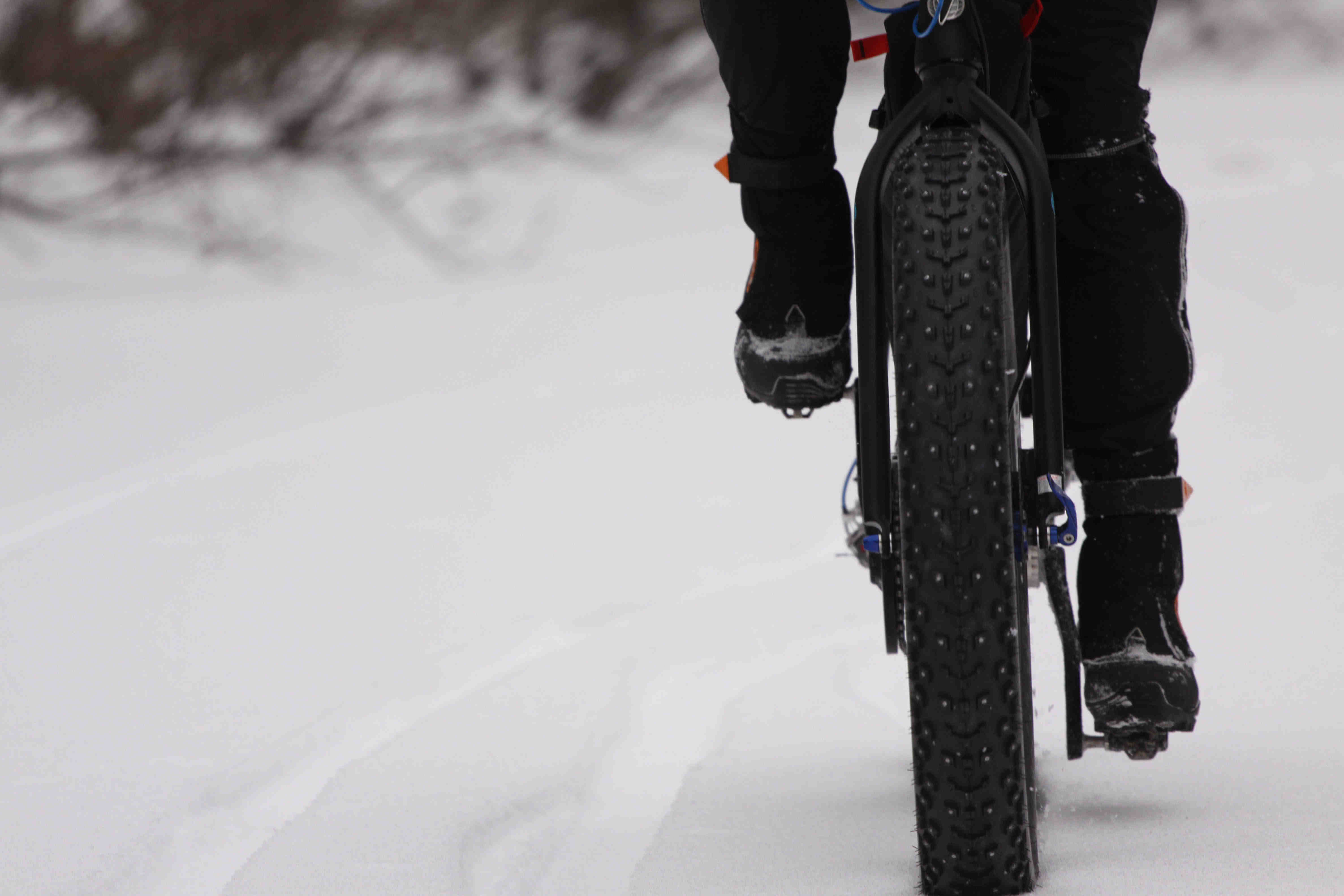
The weight of all the studs in one Dillinger is exaclty 61g - equivalent to a Greazy cap with the tags on!
Rule #3: Vanhelga tires for the win!
If conditions aren’t icy, Vanhelga tires are my favorite tire to use. They are the equivalent of velcro in loose conditions. I’ve shocked myself by being able to pedal through conditions that were the equivalent of mashed potatoes and I give all credit to my Vanhelga tires. I’ve found that they roll equally fast over hard packed conditions as well. In my opinion this is the MVP of fat bike tires. If I could only pick one tire to use, it would be the Vanhelga.
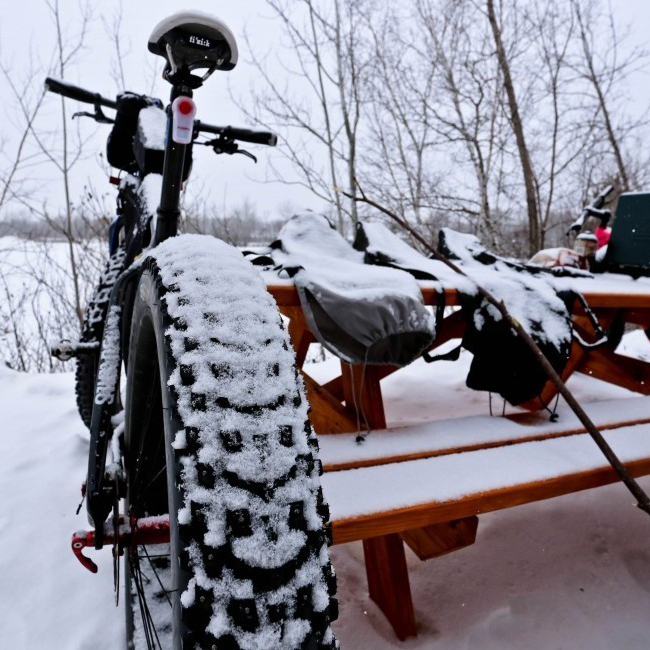
Nobody wants a flat tire, but being prepared can be the difference of finishing a ride or taking a long hike back to the car.
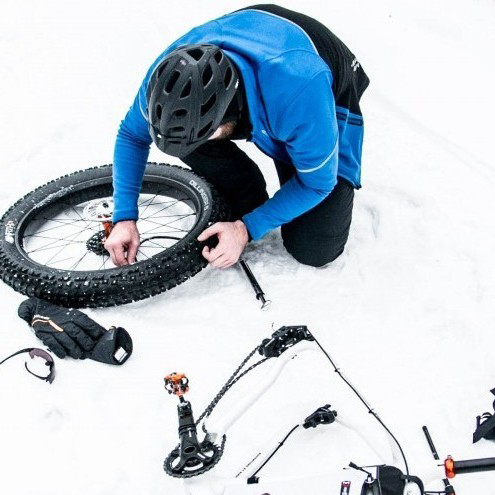
Conditions can change quickly - Don’t be afraid to adjust pressure as you go. As little as a half psi can greatly effect how the bike handles on the trail.
Rule #4: Carry a small tire pump, especially when heading out on long rides.
There will be times when you let out too much air and will want to put some back in. I experienced this first hand the second year that I raced the Winter Solstice Chase in St. Croix Falls, Wisconsin. We had really loose snow conditions and I got a little out of hand with letting air out of my tires. By the time I made it to the finish line my tires were practically flat. I’m lucky that I was able to finish and from that point on made sure that I always have a little pump shoved into my camelback.
Rule #5: If you are still unsure, feel the tires of the other fat bikers around you.
It is not uncommon to see a bunch of fat bike racers pressing down on the tires of everyone around them before the start of a race. If you notice that everyone around you is running lower tire pressure it is generally a good sign to let a little out.
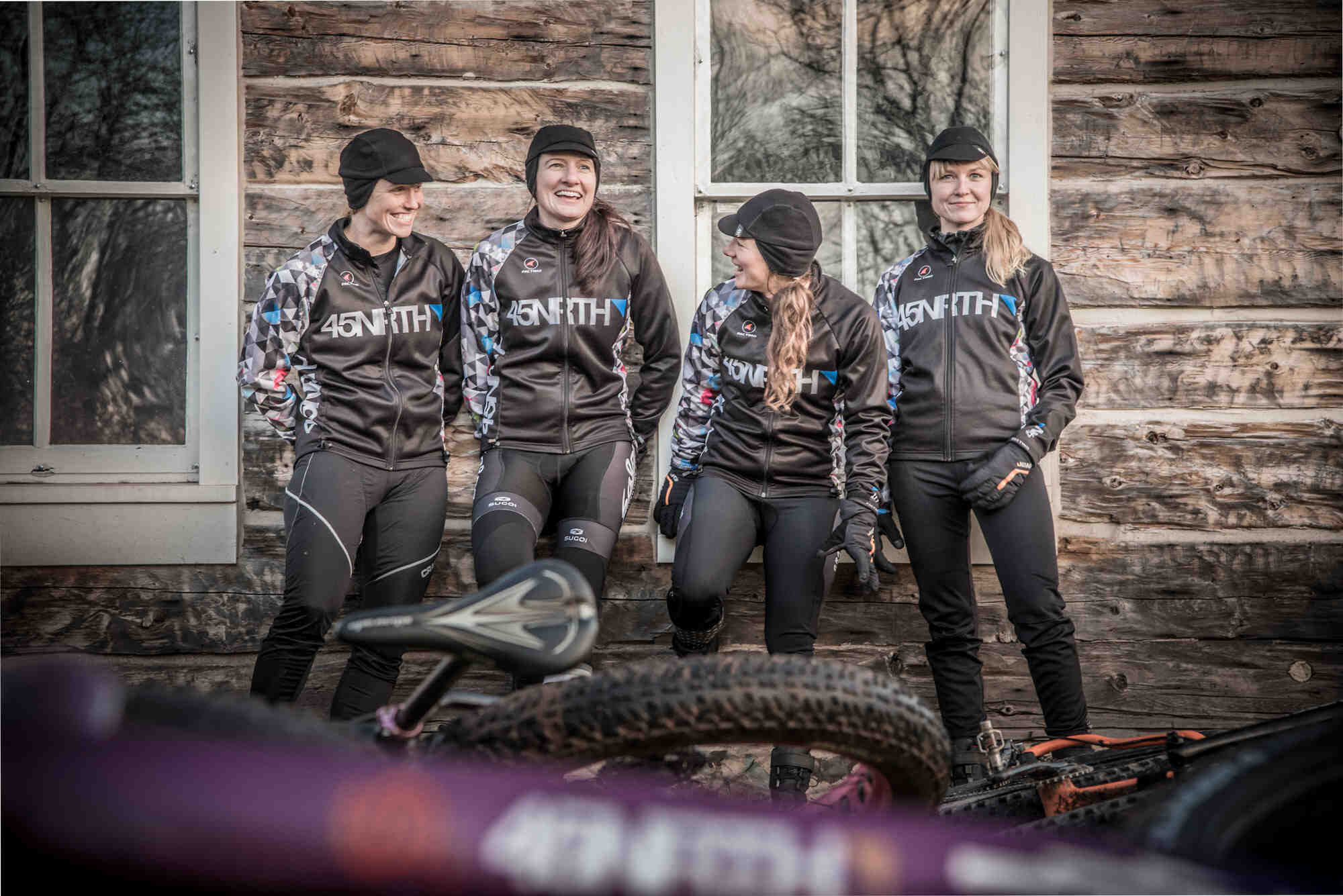
A very serious group of ladies…
Again, these are just some tips that I learned from experience and also from talking with other fat bikers. But don’t just take it from me. Below my extremely talented 45NRTH teammates share some helpful tips and experiences that they have encountered over the last couple of winters.
Tell about a time you nailed tire pressure and how it impacted your ride/race:
Chelsea Strate: I had 5 psi in the front and 5.5 psi in the rear for the Fat Chance! Race at Crystal Mountain near Traverse City, MI just a few months ago. I started with a few more pounds in each tire on my warm up, but the snow was getting chewed up from the mixture of lots of warm up traffic + the warm sunshine, and I decided to adjust before hitting the start line. It was the perfect pressure for both the flat and fast sections and the mashed potatoes. Close to the start and the finish (we had to do two laps), the snow was mostly unrideable, but I was able to float enough and ride a bit more than my competitors, and passed somebody with less than a mile to go because of it, securing a podium finish. This rider was definitely stronger than me, but my perfect tire pressure gave me just enough of a advantage!
April Morgan: I remember totally nailing the tire pressure at the Fat Bike Birkie in 2014. I remember the day before the race I had heard a ton of reports that it was super icy which made me nervous, as I did not have studs. However come Saturday morning I noticed on my pre-ride that conditions had changed quite drastically and the course was now tacky and fast – almost like cement! I made a decision to ride high tire pressure around 9-10 PSI and I remember feeling fast and amazing because of it!
Jill Martindale: Just a couple weekends ago, at the Iron Line race in Iron River, Michigan, I ran the same tire pressure with my Vanhelgas that I had used at the Arrowhead 135 just a few days before: 4.5 psi in the front and 5 psi in the rear. At the starting line, I poked some teammates tires to see what their pressure was at and I had a brief moment of panic because mine felt a lot softer than everyone else’s. Temperatures warmed up and that trail got mushy! I was so happy that I had chosen a tire/tire pressure combination that worked for me! Thanks to the float I was able to hold my position and I even got to pass a sled dog team in the slop just before the finish line!
Tell about a time you totally missed the right tire pressure and how it impacted your ride/race:
CS: A mistake I made once was not adjusting my tire pressure outdoors prior to a -12F race start temp at the Cuyuna Whiteout in 2014 (I even knew better!). I had taken some air out in the hotel room, which was close to 80F. That is about 90 degrees between to the two places. When I unloaded my bike outside, the air in my tires had compressed, and I had so little tire pressure that I was hitting my rims on the ground. To add insult to injury, my presta valve had corroded on one of my tubes, and I couldn’t put more air in, so my teammate’s husband performed the fastest fat bike tube change you’ve ever seen (it was freaking cold outside, and Tom, you’re the best!!). Two lessons learned: take into account extreme temperature change when adjusting tire pressure, and always use a valve cap if you ride on salty roads.
AM: Back in 2013 we were all just starting to race fat bikes and no one really knew what tire pressure was appropriate. Early on in the season I crashed a bunch of times riding with 10 PSI so when Frozen 40 rolled around I took the advice of a good friend and only put 4-5 PSI in both my tires (which were knobby tires). It was a very cold day and I did not pre-ride the course. Turns out the course was in MINT condition and rather than feeling fast and snappy – I felt I like I was dragging the piano around Elm Creek for nearly 5 hours! Ever since then I’ve always picked the tire pressure that was right for ME and made sure I took the time to try it out before toeing the start line.
JM: The Farmhand Fat Bike Race is the closest Great Lakes Fat Bike Series race to me - it’s held in Grand Rapids, Michigan - where I LIVE! I feel pretty silly saying that I’ve totally missed the boat on tire pressure on a race that I should have the “home-field advantage” on, but it’s true: I have messed up my tire/tire pressure on this race the last two years. Last year I ran the Dillinger 4’s at about 7 psi and the course was so soft I couldn’t stay on my bike, not even on the flats! I wound up stopping a lot to let air a lot! This year I ran the Vanhelgas with about 5 psi, theorizing that since the race was a lap race, the course would get soft and I could chug along and float my way through. The course was sheer ice and stayed hard packed, no matter how many times racers rode around and around on the course. Any time I’d try to gain some speed my rear wheel would slide out from under me. I should have ridden studded! I can’t wait to try to nail it next year!
What is one thing you wish you knew when you started riding fat bikes that you know now?
AM: That you should never dial in the tire pressure inside—-because the second you take your bike outside the cold air will cause a huge drop in tire pressure.
JM: I was really afraid to go tubeless the first year I started riding fat bikes. I was worried the fluid would freeze and I thought if I flatted the gunk would explode everywhere and putting a spare tube in would be a total disaster! I did NOT want to deal with being covered in that stuff during a race! I wish someone would have pointed out to me that the fluid wouldn’t freeze, that I can’t remember the last time I had a flat, that it makes your bike considerably lighter, and that in really mushy stuff you can run your tire pressure super low and get more float. I love running low pressure and cruising over soft and sloppy snow conditions, it’s so much fun!!
